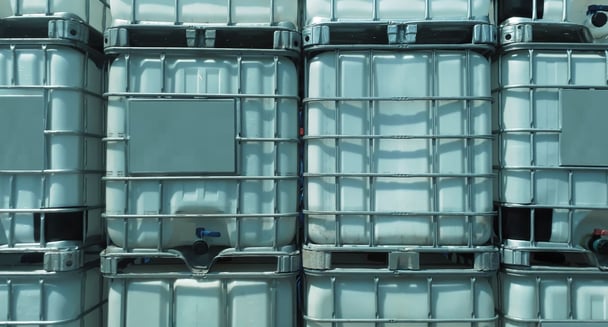“Something happened in 2020 that changed the way many businesses source and store their chemicals and other site materials, and it’s still happening today.”
One aspect of compliant intermediate bulk container (IBC) storage hinges on the unit selected. The other? Where you and your team position those units on-site and how you access them. Never was this more apparent than when walking my customers’ sites during and immediately after the pandemic, but it remains an issue when I visit new customers now.
One of the pandemic’s biggest impacts was on the supply chain. Across industries, businesses that relied on frequent deliveries of materials found those deliveries disrupted. They would either come late or in some cases not arrive at all. When you rely on those materials as a key part of your operations, that’s unacceptable, so operators began ordering larger quantities of the materials they needed to build up their supplies. This made their operations more resilient, but it also meant that their storage requirements changed.
The driver for this change was the pandemic, but those changes didn’t end when the lockdowns did. Lasting habits were formed that have meant sites today are still, by my assessment, ordering larger volumes of materials than they did pre-COVID, unlocking bulk savings and reducing the number of deliveries they need to process. At the same time, larger orders come with a drawback, or a least an implication that must be addressed.
What has this shift meant for the way those sites go on to store those materials, many of which are held in IBCs, and how could it potentially impact your IBC compliance?

More space for more product
A consequence of having more stock on site means that many sites today have more material to store. This directly impacts their storage processes and related compliance.
In a fixed environment like a workshop or a yard, it's often the case that the largest units won't fit. Due to their size, these units are typically filled with IBCs from the front and the rear, but this means they need enough space for a turning circle at the front and the rear of the unit for loading to take place. In some circumstances, the customer just doesn’t have the required space for a forklift to make these manoeuvres from both ends.
When this happens, it’s common for the unit to be pushed back against a building wall or perimeter fence. The drawback of a “pushback” unit positioned in this way is that only one side of it can be accessed. On the other hand, it helps to optimise site utilisation by only needing one turning circle at whichever end of the unit is being accessed and filled.
“Customers switched on to the fact that there's an economy of scale with bulk ordering where if they order twice as many as the IBCs containing the materials they need they will get a discount relative to the size of the order. Their storage requirements have changed directly as a result of COVID.”
|
ASK YOURSELF:
|
.png?width=645&height=515&name=Copy%20of%20Copy%20of%20HD2%20(15).png)
Temperature-controlled pushback compliance
Food manufacturers in particular will benefit from responsible pushback compliance practices, mostly due to the large volumes of temperature-sensitive liquids, essences, and other ingredients they typically store on-site, each with their own food safety regulations.
If each IBC contains temperature-sensitive ingredients to the value of £6,000, and the customer has 24 of them in a unit that isn’t heated, cooled, or otherwise temperature controlled, that’s a huge expense left to spoil. Additional costs are then incurred from needing to replace the spoiled ingredients and waste them responsibly, without the issue of temperature control ever being addressed, and so the cycle begins again.
It’s a significant cost that will eat into any food manufacturer’s bottom line, particularly those operating at scale, with multiple such units and sites falling foul of poor storage compliance.
“This is why the customer benefits so much by having me on-site. At the board level, it’s not always apparent what is being wasted or why, while operators can find themselves wasting product out of habit, without recognising the savings that could be made from reviewing their IBC storage. I help bridge those gaps.”
|
ASK YOURSELF:
|
.png?width=721&height=576&name=Copy%20of%20Copy%20of%20HD2%20(16).png)
Pushing back on poor compliance
Whether you’re driven by the opportunity to make cost-savings, improve health and safety, or your environmental obligations as a handler of IBCs containing hazardous chemicals, the best place to start when reviewing your pushback solutions is with your data sheets.
The data sheets supplied with your IBCs tell you everything you need to know about the safe use of the materials inside. That includes the recommended storage conditions as set out by the material’s manufacturer. You’ll know from reading the data sheet if a pushback unit is suitable for that material, if it requires storage within a controlled temperature, and what the associated risks are to your people and the environment.
You might have met directives four years ago, but the world has changed a lot in that time, and standards with them. IBCs are still the most hygienic, the safest, and the easiest way of moving large quantities of product because they sit comfortably on a pallet, they’re stackable, they can be reused, and they're robust. But if you have 40 of them, and they contain a hazardous chemical or liquid likely to spoil, you need to make sure you’re storing them somewhere safely and securely. By helping customers across the UK to tackle this, I’m selling much more than a storage unit. I’m raising awareness for the case of poor pushback compliance and putting a value next to it that's diminished by the solutions we provide.
Keeping on top of all this is never easy but I know exactly what to look for to quickly bring your operations back into compliance. If you’d like to chat, I’m here to help.




